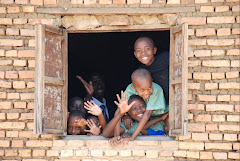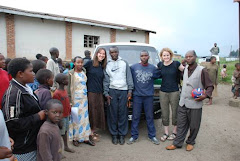Just returned from a draining weekend in Butare, the academic center of Rwanda housing the National University. It felt like a college town, an African version of course. The purpose of our visit was to attend and help out with a Darfur rally that our friend Totto was putting on along with an energetic and curious group of his fellow university peers. The event was unfortunately disappointing. I was looking forward to seeing what ideas Rwandan students had about the situation in Sudan. It was apparent that the students were empathetic to the genocidal situation, yet an evaluation of the causes and possible course of international action was not covered. Very little information or action planning occurred. The brief background that was presented was sensationalized; the images were of starving babies and battered women. It made me uncomfortable to see, but I was more uncomfortable with the Rwandan crowd’s reaction to the images. Some people gasped, or clicked in dismay while others laughed awkwardly. Uncomfortable laughter to violence seems is a common reaction, yet not a healthy one in my opinion.
I too am struggling though with how to process the emotional impact of seeing the destruction of a human life. This weekend, my cup over spilled. Murambi Memorial, the most graphic and overwhelming genocide memorial. Murambi is a village high up on a scenic plateau. It used to be the site of a rural secondary school. During the genocide, Tutsi’s and moderate Hutu's were told to take refuge in the school; they were informed that they would be safe. Nearly 50,000 people fled to the school but they were not safe. The sheer number of victims was overwhelming; the natural beauty that silently witnessed the massacre was disturbing; our tour guide who was the only surviving member of his family and who has stayed on as groundskeeper ever since 1994 was painful; the plaque recognizing the site where French troops had played volley ball during Operation Turquoise was enraging(Operation Turquoise is an infuriating research topic for anyone interested in learning more about the international role in the 1994 genocide. A French documentary entitled Operation Turquoise was being filmed in Butare during our stay and should be out soon); the memorial was more than my soul could take. Like other memorials, the site remained untouched and unchanged. Yet, at Murambi the victims had not been moved. The last moment of life was seen on their mummified faces. I could never be prepare to face what I saw as I walked into one room after another. The odor was overwhelming, but it was not the odor of death, it was the odor of sheer evil. I wish I could end by saying a blank comment like, may they rest in peace, but I fear that the victims do not rest in peace.
Sunday, July 8, 2007
Subscribe to:
Post Comments (Atom)






4 comments:
Katy,
Do Rwandans go to view the school? Do they go to see their loved ones' bodies? Why don't they bury their dead? Isn't it full of "Composting" bugs & microbes so to speak?
This is such a disturbing image, but it's the aftermath of an even more horrific cause--a slaughter.
Do the tribes still hate eachothr, or are they vying for who gets the resources? this is all so confusing and disturbing--at a distance. I cannot imagine what you are feeling.
Be Safe, my dear.
Katy,
You mentioned the uncomfortable, unhealthy crowd reaction to the Darfur images. Their psyche has to be totally whacked after living through their genocide and now exposed to another in Darfur. And I have no doubt that their heritage of colonialism was brutal. Rwanda seems like trying to raise your children with a video game, or Mel Gibson violence fest playing 24/7! How can continual exposure to the worst of human behavior, result in an untroubled person.
The Jews in concentration camps had their rich social and religious heritage to remind them of the goodness and decency in humanity. Do they have anything like that in Rwanda? Do they have traditions? Story-telling? Rituals? Holidays? Heros, either secular, or religious? They must need to be reminded of the good within their culture so they can --be good once again.
As a mother (and I know this may sound simplistic) Rwanda does not need to see evil any more. Enough focus on bad behavior! Go to your room and read a good book! Remind your national psyche that when the sun sets, and it is dark...the sun always rises again.
Bury your dead and remember them with love, not with horror.
I know I sound preachy, Katy, but I'm trying to process what you're telling us. It must be a comfort to you to have such a deep belief in. and knowledge of humanity's kindness, love and decency
Katy, I am reading this with Adrian. He sorry he hasn't been near a computer. He too is feeling overwhelmed by what you wrote. I applaud your bravery. I could not have walked in that building. I know what you mean about the overwhelming aire of evil it was the same at Auchwitz. You could feel the evil presence. Take care of yourself. Do something just for you.
This is Adrian... Katy, I miss you and I am a little worried, remeber stay away from those guys 1/4 has AIDS. I heard of Kilamanjaro please bring pictures. Why did they choose to leave all the bodies like that? Isn't there a risk of disease from being around all those dead bodies. My science teacher taught me that. I have to go Erin needs to write me a letter for habitat. Hope you have a good time keep your head up. Love Adrian
Katy,
I am so glad...and this sounds strange...that you are there to witness this for all of us. You are strong and wise beyond your years, and someone like you will get more out of experiencing this than others might.
We Americans sanitize death, we clean up our "road kill" quickly, we bury our dead with no wails or moans, we close our caskets and move on saying to ourselves "It's time to think of the future". We place bronze statues up to honor our dead, pretty, clean and neat. And yet...does that really help us move forward? That famous phrase "those who don't remember history are doomed to repeat it" is true, and what great way to remember than to see the actual bodies where they fell, to envision the horror that they endured during the massacre...all things that a bronze memorial statue could never comvey. What may be hard for us to view may also teach us the most...
Love you,
Cindy
Post a Comment